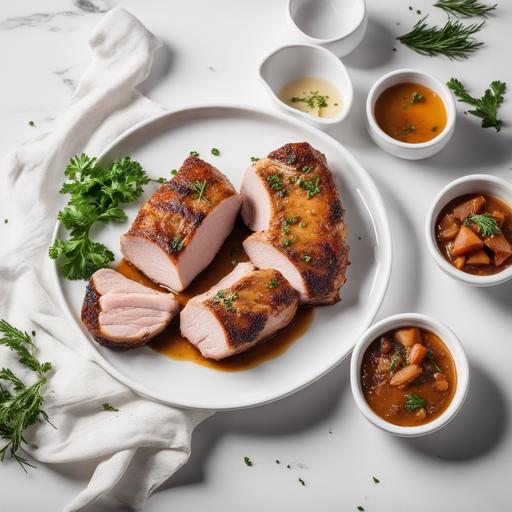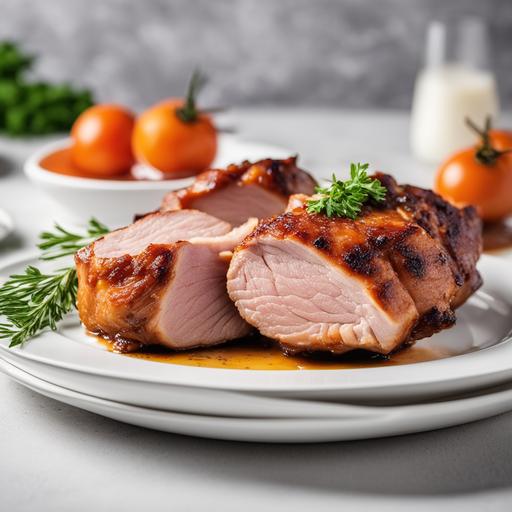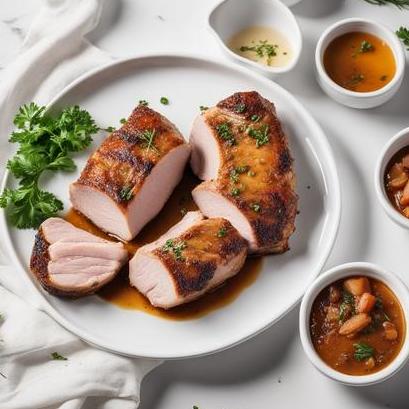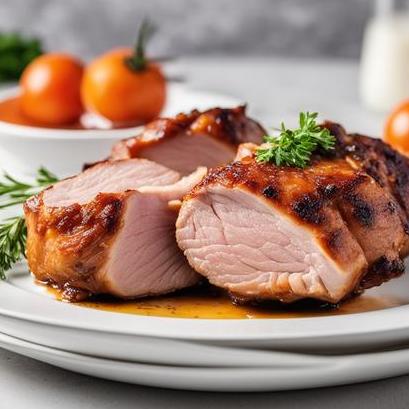
Pork Loins Oven Recipe: A Delicious And Juicy Delight
Whether you are a seasoned cook or a novice in the kitchen, pork loins cooked in the oven are a delightful treat that will elevate your culinary skills to new heights. With their delectable taste, juicy texture, and versatility, pork loins are a perfect choice for any occasion. In this comprehensive guide, we will delve into the intricacies of preparing a mouthwatering pork loin dish. From understanding the food science behind its succulence to the step-by-step culinary details, we will cover everything you need to know to create a memorable pork loin experience. So, let’s roll up our sleeves, don our aprons, and embark on this flavorsome journey!
The Science Behind Perfectly Cooked Pork Loins
Understanding the science behind cooking pork loins in the oven is crucial for achieving optimal results. Pork loin is a lean cut of meat that can easily dry out if not cooked properly. To ensure a succulent and juicy outcome, it is essential to comprehend the role of temperature and time in the cooking process.
Temperature Matters
The internal temperature of pork loins is a vital factor in determining its doneness. The United States Department of Agriculture (USDA) recommends cooking pork to an internal temperature of 145°F (63°C) with a three-minute rest time before consuming. At this temperature, the meat is safe to eat while retaining its tenderness and juiciness.
The Role of Time
While temperature is essential, cooking time also plays a crucial role in achieving the desired doneness of your pork loins. Overcooking can result in dry and tough meat, while undercooking might lead to unsafe consumption. It is important to strike the perfect balance to achieve the best results.
Selection and Cleaning of Pork Loins
When it comes to selecting pork loins for your oven recipe, certain criteria will ensure the finest quality and flavor. Follow these tips to make a wise choice:
-
Choose Freshness: Look for pork loins that have a vibrant pink color and are free from any grayish tones. Freshness is key to a flavorsome outcome.
-
Marbling: Opt for pork loins with a thin layer of fat running through the meat. The intramuscular fat, known as marbling, adds flavor and tenderness to the finished dish.
Once you’ve selected your perfect pork loin, it’s time to prepare it for cooking. Follow these steps for cleaning:
-
Rinsing: Rinse the pork loin under cold running water to remove any impurities.
-
Pat Dry: Gently pat the pork loin with paper towels to remove excess moisture. This will help achieve a golden brown crust during cooking.
Preparing the Pork Loins for Oven Cooking

Proper preparation is essential for maximizing flavor and tenderness in your pork loins. Follow these steps to ensure a delicious outcome:
-
Trimming: Trim any excessive fat from the pork loin, leaving a thin layer intact to enhance flavor and moisture.
-
Seasoning: Rub your pork loin with a mixture of your favorite herbs and spices. Popular options include rosemary, garlic, thyme, and paprika. The choice is yours! Be generous with the seasonings to infuse the meat with aromatic flavors.
Tips and Variations for a Lip-Smacking Experience

To elevate your pork loins oven recipe, try incorporating these tips and variations:
-
Brining: Brining your pork loin before cooking can enhance its juiciness and tenderness. Create a brine using a mixture of salt, sugar, and water. Submerge the pork loin in the brine for a few hours before rinsing and patting dry.
-
Stuffing: Get creative by stuffing your pork loins with various fillings. Whether it’s a combination of apples and sage or a blend of spinach and cheese, the possibilities are endless. This adds another layer of flavor and texture to your dish.
Checking Doneness and Preventing Under/Overcooking

Properly gauging the doneness of your pork loin is essential to ensure a safe and enjoyable eating experience. Here’s how to check for doneness:
-
Using a Meat Thermometer: Insert a meat thermometer into the thickest part of the pork loin without touching the bone. When the internal temperature reaches 145°F (63°C), your pork loin is perfectly cooked.
-
Let it Rest: After removing the pork loin from the oven, let it rest on a cutting board for three minutes. This allows the juices to redistribute, resulting in a moist and flavorsome meat.
-
Avoid Overcooking: To prevent overcooking, it’s best to remove the pork loin from the oven a few degrees before reaching the desired internal temperature. The residual heat will continue cooking the meat, and you’ll achieve the perfect doneness every time.
A Mouthwatering Pork Loins Oven Recipe

Now that we have explored the science, preparation, and tips for cooking pork loins in the oven, it’s time to unveil a delicious recipe that will leave your taste buds dancing with joy!
Ingredients:
-
2 pounds (900g) of pork loin
-
2 tablespoons of olive oil
-
2 cloves of garlic, minced
-
1 tablespoon of fresh rosemary, finely chopped
-
1 tablespoon of fresh thyme, finely chopped
-
Salt and pepper to taste
Instructions:
-
Preheat your oven to 375°F (190°C).
-
In a small bowl, combine minced garlic, rosemary, thyme, olive oil, salt, and pepper.
-
Rub the mixture over the entire surface of the pork loin, ensuring an even coating.
-
Place the seasoned pork loin into a baking dish or onto a baking sheet.
-
Roast the pork loin in the preheated oven for approximately 25-30 minutes per pound (500g), or until the internal temperature reaches 145°F (63°C).
-
Once cooked, remove the pork loin from the oven and let it rest for three minutes on a cutting board.
-
Slice the pork loin into desired portions and serve hot.
Final Words of Encouragement
Cooking pork loins in the oven may seem daunting, but with the right techniques and attention to detail, you can create a mouthwatering dish that will impress your family and friends. Remember to select quality meat, prepare it with care, and monitor its doneness using a meat thermometer. The possibilities for variations and experimentation are endless, so let your creativity shine!
So, put on your chef’s hat, fire up your oven, and get ready to savor the succulent goodness of perfectly cooked pork loins. Happy cooking, and bon appétit!
Sources
FAQS On Pork Loins Oven Recipe
What Is The Recommended Temperature And Cooking Time For Pork Loins In The Oven?
The recommended temperature for cooking pork loins in the oven is typically 375°F (190°C). The cooking time can vary depending on the size and thickness of the pork loins. As a general guideline, pork loins weighing around 2 to 3 pounds (0.9 to 1.4 kg) should be cooked for approximately 25 to 30 minutes per pound (0.45 kg) until the internal temperature reaches 145°F (63°C) for medium rare or 160°F (71°C) for medium.
How Should I Season The Pork Loins For Optimal Flavor?
To enhance the flavor of your pork loins, it is recommended to season them generously with a blend of spices and herbs. A classic combination for pork loin seasoning includes kosher salt, black pepper, garlic powder, dried thyme, and smoked paprika. Rub the seasoning mixture all over the pork loins, making sure to coat them evenly before placing them in the oven.
Should I Marinate The Pork Loins Before Baking Them In The Oven?
While marinating pork loins can impart additional flavor, it is not necessary for this particular oven recipe. The dry seasoning rub mentioned earlier will provide ample flavor to the meat. However, if you prefer a marinated pork loin, you can prepare a marinade using ingredients such as soy sauce, Worcestershire sauce, olive oil, garlic, and herbs. Allow the pork loins to marinate in the mixture for at least 2 hours or overnight in the refrigerator before proceeding with the oven baking method.
How Can I Ensure That The Pork Loins Stay Moist And Juicy During Cooking?
To maintain moisture and juiciness in your pork loins, it is important not to overcook them. Overcooking can result in dry and tough meat. Using a meat thermometer is highly recommended to monitor the internal temperature. Remove the pork loins from the oven when the thermometer reads 145°F (63°C) for medium rare or 160°F (71°C) for medium, as these temperatures ensure optimal taste and texture. Once out of the oven, allow the pork loins to rest for about 5 to 10 minutes before slicing to retain their juiciness.
Can I Add Vegetables To The Baking Dish With The Pork Loins?
Absolutely! Adding vegetables to the baking dish along with the pork loins can not only provide a complete meal but also result in a delicious one-pan dish. Vegetables such as potatoes, carrots, onions, and Brussels sprouts work well for roasting alongside the pork loins. Simply toss the vegetables in olive oil, salt, and pepper, and arrange them around the pork loins in the baking dish. Ensure that the vegetables are evenly spread for even cooking. The juices from the pork will also enhance the flavors of the vegetables.


